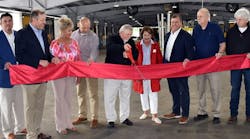Homeowners and private non-residential property owners have started performing maintenance activities that had been put off during the recession. Consumption of building materials is rising as a result, creating a bit of an uptick in building materials freight volumes. This recovery, though, will be sluggish as new construction activity will remain at depressed levels for an extended period due to excess supply of residential and private non-residential real estate, soft demand and tight credit availability.
Residential construction activity is forecast to remain at depressed levels through at least 2011. The continued large numbers of home foreclosures will remain a drag on new housing construction by keeping the supply of homes for sale at high levels.
The Federal Reserve's second quantitative easing policy with the intention of lowering long-term interest rates will provide a marginal stimulus on housing starts and new private residential construction. A moderate decrease in long-term interest rates will result in only a marginal stimulus in housing demand, since interest rates are already at extremely low levels and credit availability will remain tight.
Quantitative easing does not correct for excess supply of office, retail and industrial space either, so private non-residential construction activity will remain at depressed levels. The downturn in private non-residential construction activity was not the result of high interest rates that reduced demand, so a moderate decrease in long-term interest rates from already low levels will result in a marginal stimulus in demand. Tight credit availability will remain a drag on new private non-residential construction activity over the next few years.
In spite of weak new construction spending, building materials sales have begun to recover stimulated by maintenance activities related to depreciation. Sluggish growth in building materials sales will pull commodities through the supply chain, resulting in higher output since inventories are in equilibrium throughout the supply chain. Moderate growth in building materials sales (Chart A) will cause retailers and wholesalers to rebuild stocks.
In the first nine months of 2010, output of building materials products (Chart B) increased 2.8% from the same period in 2009. Commercial Motor Vehicle Consulting predicts output of building materials will continue to slowly trend upward as home and building maintenance activities stimulate consumption of products. Output of building materials in the first nine months of 2010 was 22% below 2007's level, the year before the recession. Carriers had reduced capacity in response to lower freight volumes, but such a large decrease in freight volumes within a short period of time implies capacity is available to meet moderately expanding freight volumes.
In the short term, the pricing environment will remain competitive for carriers with a high concentration of hauling building materials, but the pricing environment will slowly improve over time as a result of moderate growth in freight volumes.
Commercial Motor Vehicle Consulting publishes the monthly newsletter “Visibility of the Supply Chain” for general freight carriers. To order a copy, contact Chris Brady of CMVC at [email protected] or 516-869-5954.


